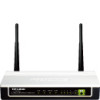TP-Link TD-W8961NB TD-W8961NB User Guide - Page 62
Upnp, 5.4 Ddns - password
 |
View all TP-Link TD-W8961NB manuals
Add to My Manuals
Save this manual to your list of manuals |
Page 62 highlights
TD-W8961NB 4.5.3 UPnP 300Mbps Wireless N ADSL2+ Modem Router User Guide Choose "Access Management→UPnP", you can configure the UPnP in the screen (shown in Figure 4-43). UPnP (Universal Plug and Play) is a distributed, open networking standard that uses TCP/IP for simple peer-to-peer network connectivity between devices. An UPnP device can dynamically join a network, obtain an IP address, convey its capabilities and learn about other devices on the network. In turn, a device can leave a network smoothly and automatically when it is no longer in use. UPnP broadcasts are only allowed on the LAN. Figure 4-43 ¾ UPnP: Activate or Deactivate the UPnP function. Only when the function is activated, can the UPnP take effect. ¾ Auto-Configure: If you activate the function, then the UPnP network devices can automatically configure network addressing, announce their presence in the network to other UPnP devices and enable exchange of simple product and service descriptions. 4.5.4 DDNS Choose "Access Management→DDNS", you can configure the DDNS function in the screen (shown in Figure 4-44). The router offers a Dynamic Domain Name System (DDNS) feature. The feature lets you use a static host name with a dynamic IP address. User should type the host name, user name and password assigned to your ADSL Router by your Dynamic DNS provider. User also can decide to turn on DYNDNS Wildcard or not. 56















